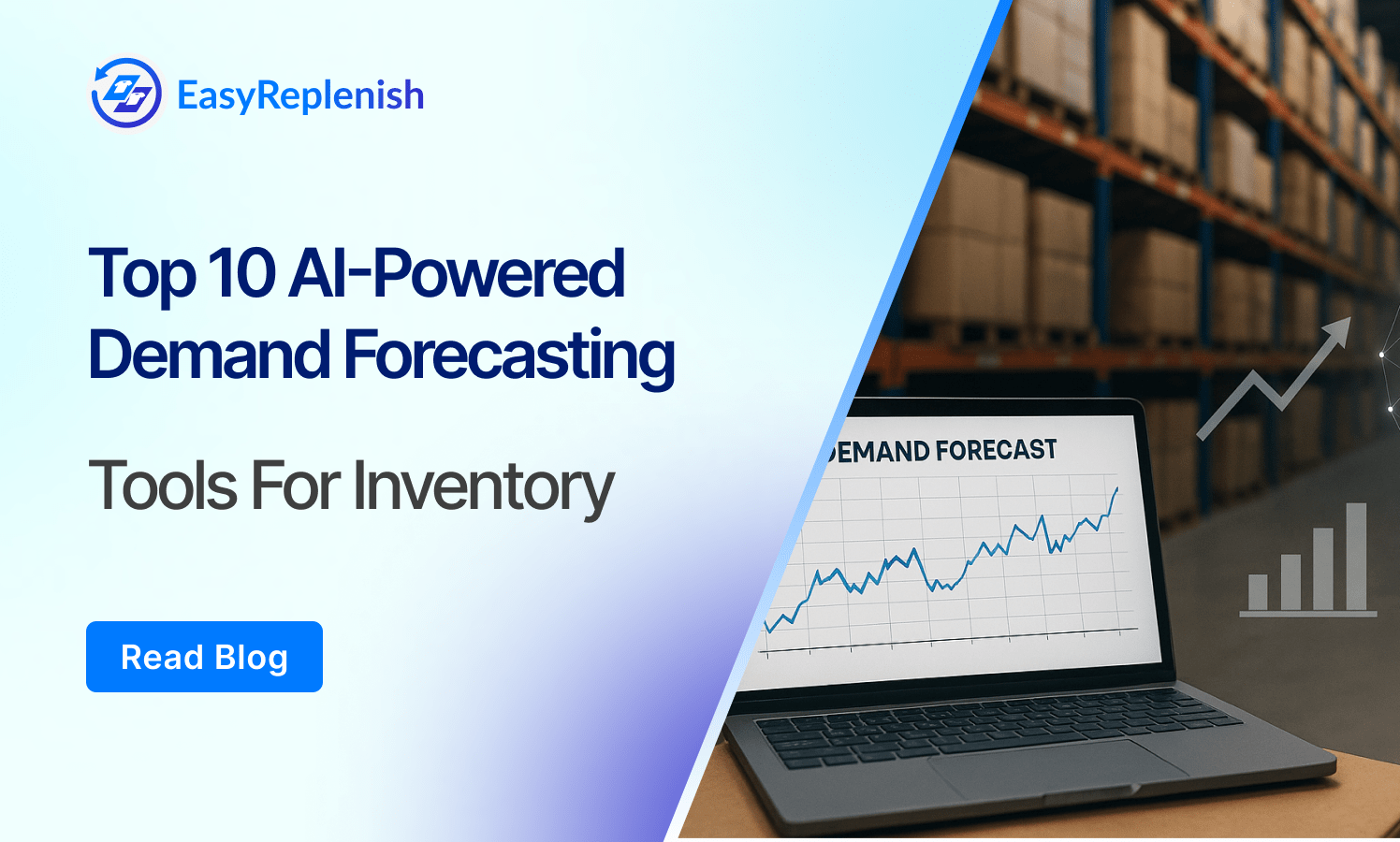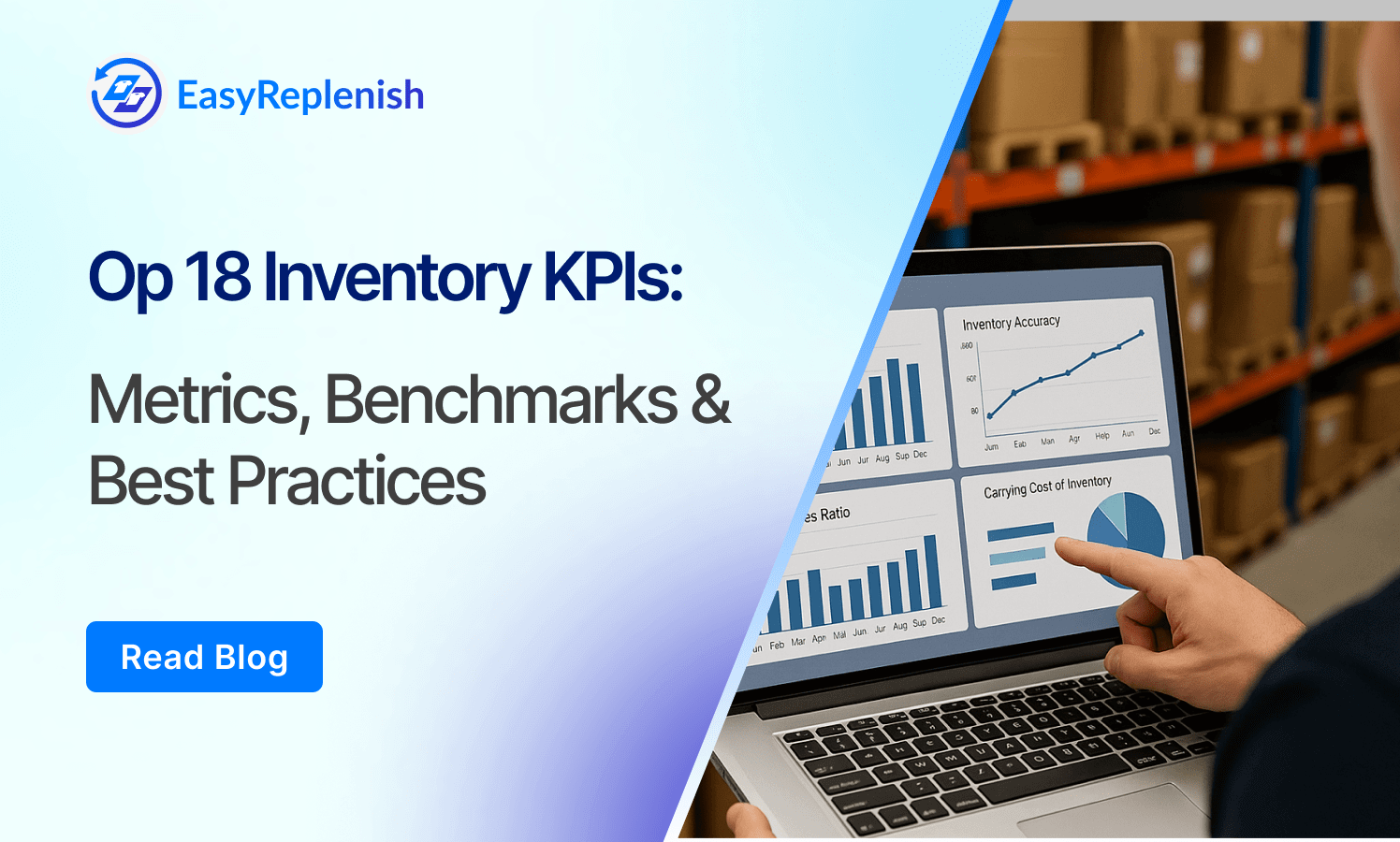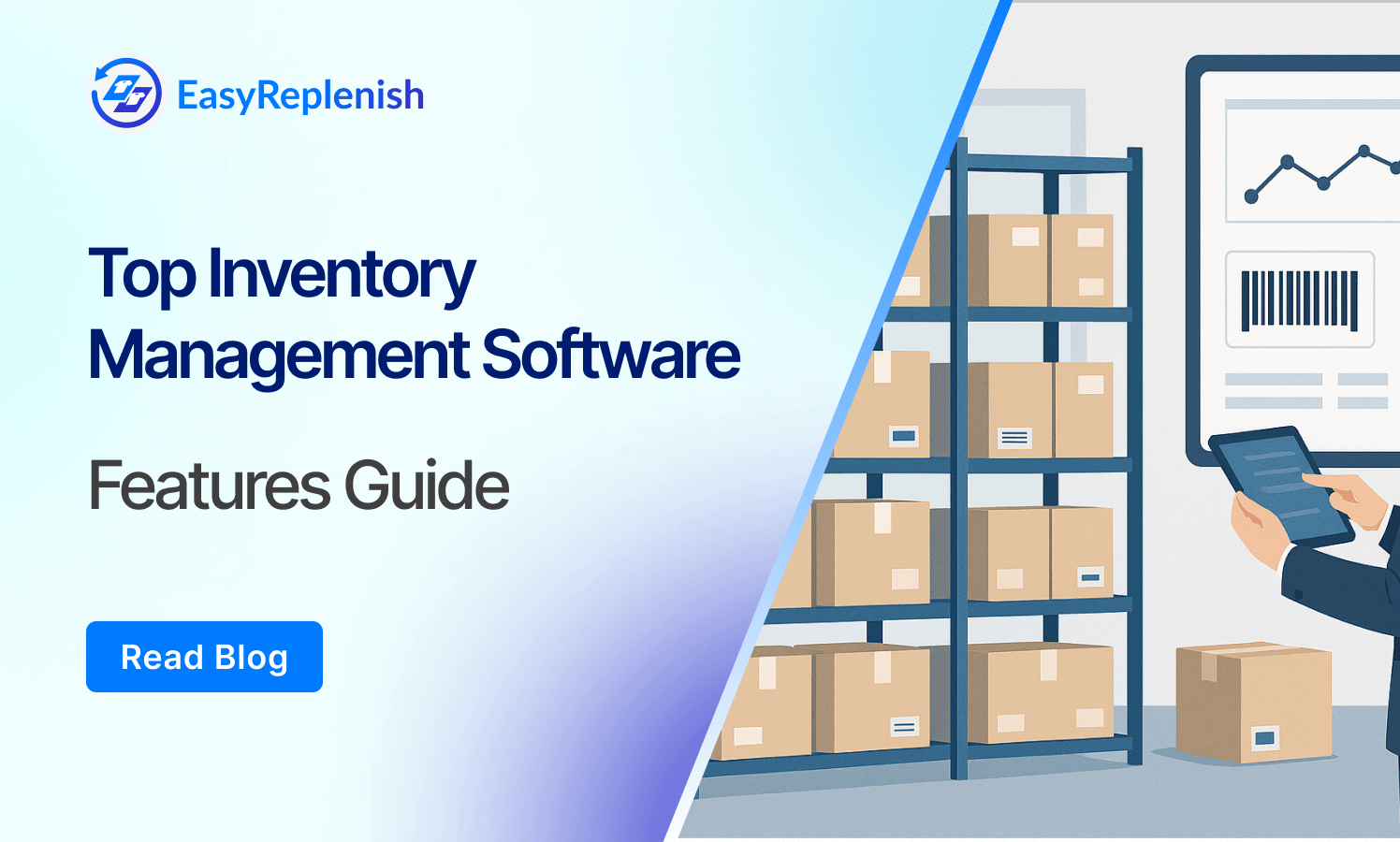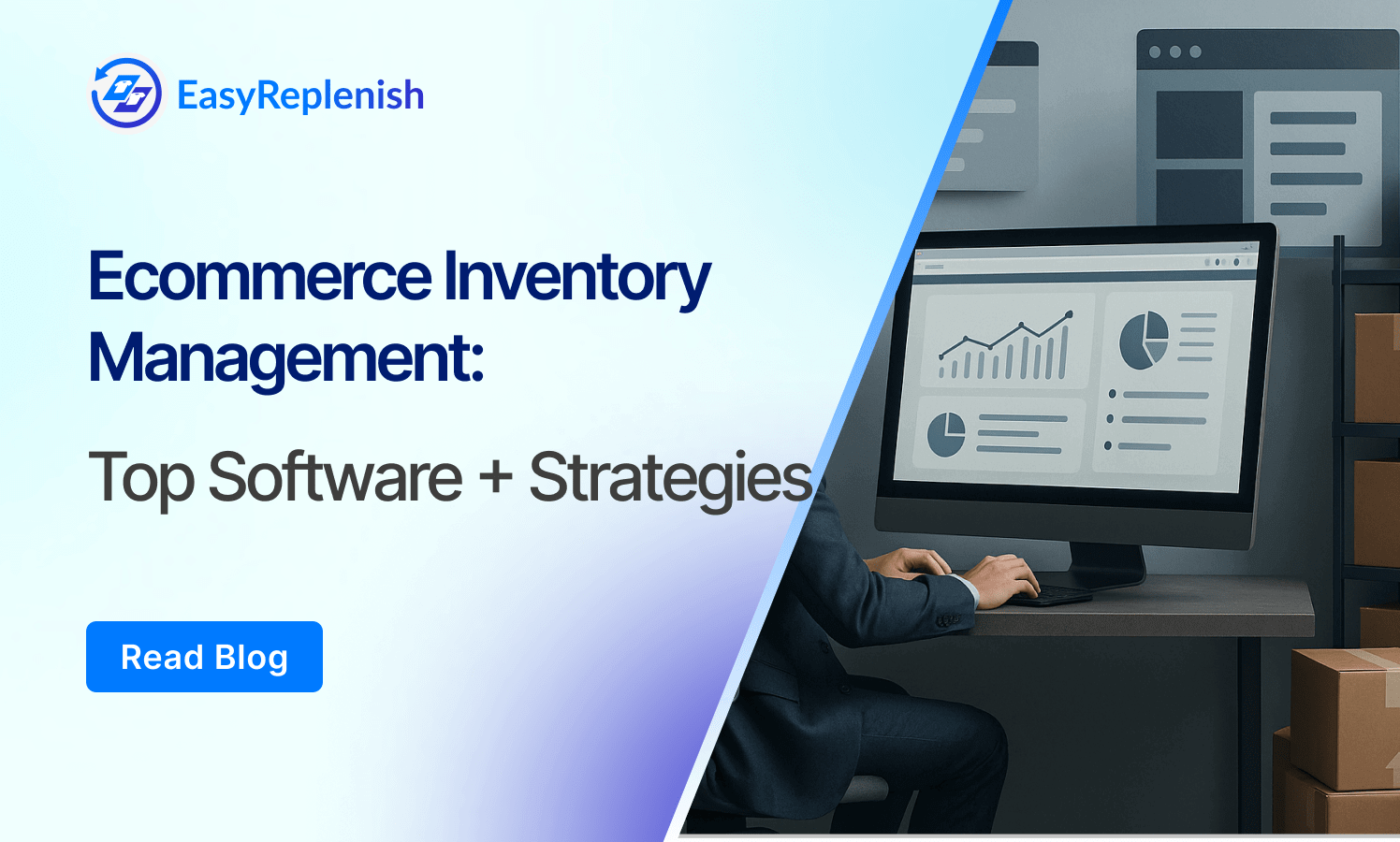11 Inventory Management Methods Explained with Examples
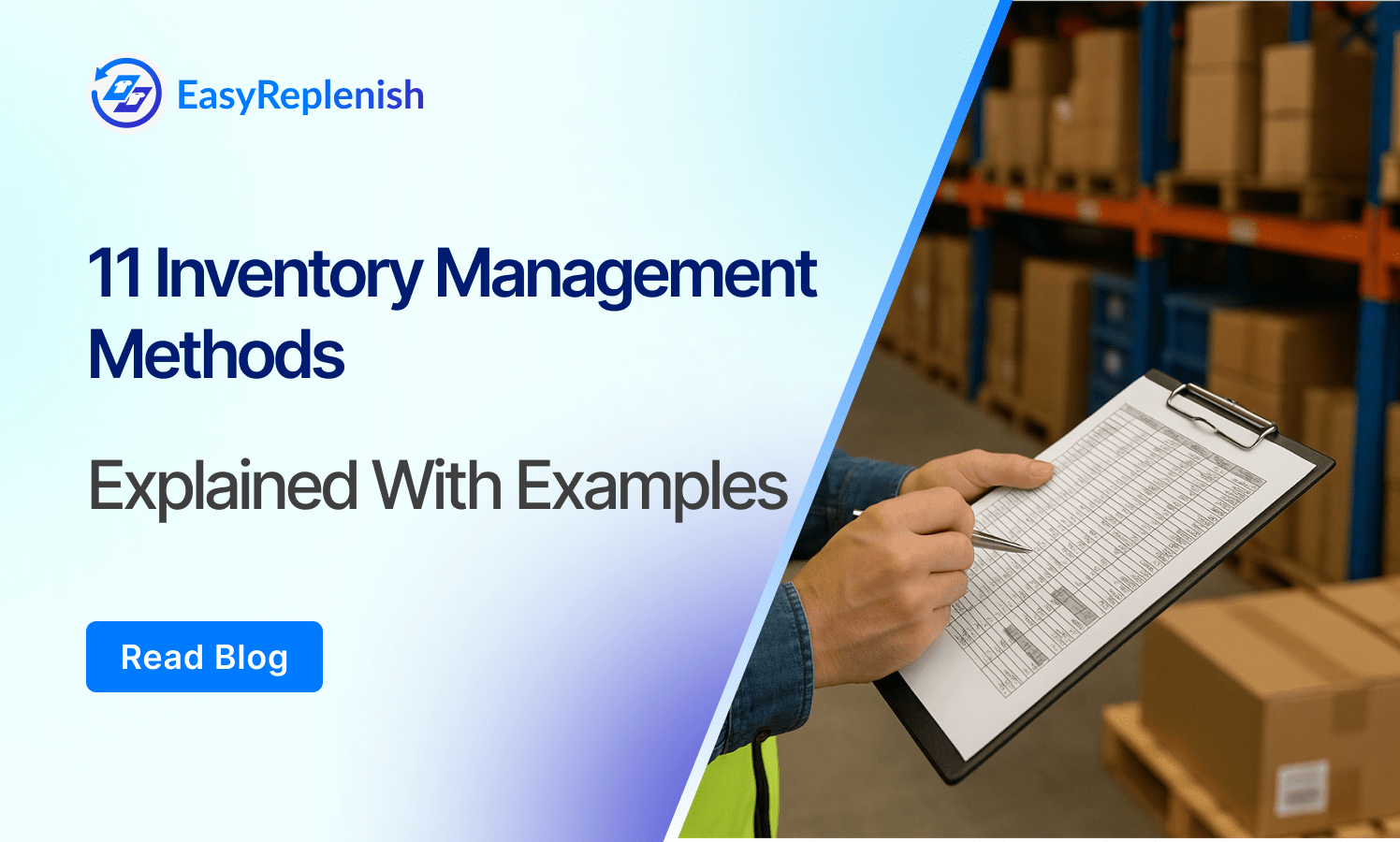
Inventory isn’t just what’s sitting on your shelves or in your warehouse — it’s capital, customer satisfaction, and operational agility tied together. The way you manage it can quietly decide whether your business thrives or struggles. Choose the wrong inventory management method, and you could lock up cash in slow-moving products, miss sales because of stockouts, or watch costs climb as inefficiencies multiply. Choose the right one, and you unlock smoother operations, better cash flow, and the ability to scale without chaos.
Every business — from a fashion retailer juggling seasonal collections to a manufacturer coordinating production schedules — needs a deliberate approach to managing stock. But with methods ranging from FIFO and LIFO to Just-in-Time and AI-driven replenishment, the real challenge isn’t knowing what the methods are. It’s knowing which one will work for your industry, your sales model, and your growth goals.
In this guide, we’ll break down the most widely used inventory management methods, highlight where each shines or falls short, and give you the practical insights you need to choose a strategy that aligns with your business realities — not just the textbook definition.
Understanding Inventory Management Methods
At its core, an inventory management method is the framework you use to decide how inventory is tracked, valued, replenished, and controlled. It’s the playbook that guides what gets ordered, when it gets ordered, and how it’s accounted for in your books.
There are two main categories:
- Inventory valuation methods – Accounting-focused approaches like FIFO (First-In, First-Out), LIFO (Last-In, First-Out), Weighted Average Cost, and Specific Identification. These determine how the cost of goods sold (COGS) and ending inventory value are calculated for financial reporting and tax purposes.
- Inventory control & replenishment methods – Operational approaches like Just-in-Time (JIT), Economic Order Quantity (EOQ), ABC Analysis, and Reorder Point. These focus on how stock is physically managed, when replenishment happens, and how much to order.
In practice, many companies use a hybrid approach — for example, a fashion retailer might use FIFO for valuation and ABC analysis + seasonal replenishment for operational control. The method or combination you choose directly affects:
- Profitability – through cost efficiency and reduced wastage
- Cash flow – by optimizing working capital tied up in stock
- Customer satisfaction – ensuring the right products are available at the right time
Understanding these methods isn’t just about compliance or theory — it’s about aligning inventory practices with your business model so they actively support growth instead of silently draining resources.
Inventory Management Methods
Inventory management methods can be broadly grouped into valuation methods (how inventory costs are calculated) and control/replenishment methods (how inventory is physically managed and ordered). Many businesses blend approaches to fit their operational and financial needs.
1. First-In, First-Out (FIFO)
How it works:
FIFO assumes that the inventory purchased or produced first is sold first. In practical terms, the oldest stock leaves your shelves before the newer stock, aligning closely with the natural product flow in most industries.
Why it matters:
In industries where products have a shelf life — think fresh produce, pharmaceuticals, cosmetics, or seasonal fashion collections — selling older items first prevents spoilage, obsolescence, and markdown losses. It also produces a more realistic inventory valuation during periods of stable or rising prices, since the remaining stock reflects the most recent (and often higher) costs.
Business impact:
- Financial: During inflation, FIFO results in lower cost of goods sold (COGS) and higher reported profits. This can improve investor perception but may also increase your tax liability.
- Operational: Reduces waste, improves inventory turnover, and aligns with physical stock rotation in warehouses and stores.
- Customer experience: Ensures customers get fresher or newer products, boosting satisfaction and brand trust.
Example:
A fashion retailer using FIFO ensures that last winter’s coats are sold before this year’s production hits the floor. This not only clears space for the new line but avoids having to deeply discount unsold stock at the end of the season.
2. Last-In, First-Out (LIFO)
How it works:
LIFO assumes the most recently purchased or produced inventory is sold first. This is more of an accounting method than a physical flow strategy — few businesses physically ship newest goods before older ones unless the product has no shelf-life concerns.
Why it matters:
In markets experiencing consistent inflation, LIFO can lower taxable income by matching current higher costs with current sales revenue, increasing COGS on paper. This is particularly relevant for U.S. businesses, as LIFO is not permitted under International Financial Reporting Standards (IFRS).
Business impact:
- Financial: Reduces taxable income in inflationary periods but also lowers reported profits, which can influence investor confidence.
- Operational: Rarely changes actual warehouse operations, but may cause discrepancies between accounting inventory value and physical stock rotation.
- Strategic consideration: Can be beneficial in industries where raw material costs are volatile and consistently rising, such as construction materials, chemicals, or certain manufacturing sectors.
Example:
A U.S.-based building materials distributor uses LIFO to match the cost of lumber purchased at $400 per unit today against current sales, instead of older $250-per-unit stock. This raises COGS and lowers taxable profit during inflation spikes.
3. Weighted Average Cost (WAC)
How it works:
WAC calculates the average unit cost of all inventory available during a given period, dividing the total cost of goods available by the total units available. Each item sold is valued at this average cost, smoothing out price fluctuations.
Why it matters:
This method is ideal for businesses with high volumes of interchangeable products where tracking individual purchase prices isn’t practical — think bulk packaging, chemicals, or commodity-based goods. It simplifies accounting while keeping valuation reasonably accurate in fluctuating markets.
Business impact:
- Financial: Smooths cost variations, avoiding large swings in COGS from one reporting period to the next.
- Operational: Reduces complexity in systems, particularly when items from multiple purchase lots are commingled in storage.
- Decision-making: Makes it easier for managers to assess gross margins without being distracted by cost spikes on specific lots.
Example:
A beverage manufacturer buying sugar multiple times per month at different prices blends all batches together during production. WAC allows them to assign a single average cost to every unit produced, rather than tracking each purchase separately.
4. Specific Identification
How it works:
Specific identification tracks the exact cost of each individual inventory item. When a product is sold, the actual cost associated with that exact item is recorded as COGS. This is only possible when each unit is clearly identifiable — typically via serial numbers, RFID tags, or detailed batch tracking.
Why it matters:
For high-value, low-volume products where every item’s cost is significant (and may vary greatly from others in the same category), accuracy in valuation is critical. It ensures precise profit calculations, better warranty and returns handling, and compliance with accounting standards for luxury, custom, or specialized goods.
Business impact:
- Financial: Delivers the most accurate match between actual cost and sales revenue, ensuring margins are reported exactly.
- Operational: Supports precise inventory visibility, aiding customer service in cases like custom orders or replacements.
- Strategic: Especially valuable for after-sales service, warranty claims, or regulated industries that require lot traceability.
Example:
A fine jewelry retailer selling diamond rings keeps detailed records of each ring’s purchase cost, grading certificate, and serial number. When one ring sells for $10,000, the exact $6,200 purchase cost is recorded in the books, giving a precise profit calculation.
5. Just-in-Time (JIT)
How it works:
Just-in-Time is an operational strategy where inventory is purchased or produced only when it is needed, minimizing holding costs. Instead of keeping large amounts of stock on hand, JIT relies on highly reliable suppliers, accurate demand forecasting, and efficient logistics to keep materials and products flowing exactly in sync with demand.
Why it matters:
JIT reduces capital tied up in inventory, lowers storage costs, and minimizes waste from obsolescence or expiry. However, it shifts risk onto the supply chain — a delay from a supplier can quickly lead to missed production runs or stockouts.
Business impact:
- Financial: Significantly reduces working capital requirements and warehouse overheads.
- Operational: Improves efficiency and space utilization, but requires airtight supplier relationships and real-time visibility.
- Risk management: Vulnerable to disruptions from transportation delays, geopolitical instability, or sudden demand spikes.
Example:
An electronics assembler sources critical components from suppliers who deliver within 48 hours of order placement. Instead of holding a month’s worth of parts, the company keeps only a two-day buffer, freeing up warehouse space and cash for other operational needs.
6. Economic Order Quantity (EOQ)
How it works:
EOQ is a formula-based method that determines the optimal order quantity to minimize the combined costs of ordering and holding inventory. It factors in demand rate, ordering costs, and holding costs to identify the sweet spot where these costs are lowest.
The EOQ formula is:
EOQ = Square Root of (2 × Annual Demand × Ordering Cost) ÷ Annual Holding Cost per Unit
Where:
- D = Annual demand (units)
- S = Ordering cost per order
- H = Annual holding cost per unit
Why it matters:
EOQ gives decision-makers a data-backed order quantity, preventing the guesswork that can lead to overstock or stockouts. It’s especially effective in stable-demand environments where cost structures are predictable.
Business impact:
- Financial: Balances carrying costs with order frequency to reduce total cost of inventory ownership.
- Operational: Prevents excess storage needs while ensuring stock availability.
- Strategic: Provides a baseline for replenishment that can be fine-tuned with real-time demand data.
Example:
A packaging supplier with steady monthly demand for cardboard boxes calculates that ordering 5,000 units every two months minimizes both warehouse rent and supplier order fees. This EOQ-based schedule saves the company roughly 12% in inventory costs annually.
7. ABC Analysis
How it works:
ABC Analysis classifies inventory into three categories based on their impact on overall inventory value and business performance:
- A items: High-value products that account for a relatively small portion of inventory volume but a large portion of total value (typically 10–20% of items make up 70–80% of value).
- B items: Moderate-value products that have a balanced contribution to both volume and value.
- C items: Low-value products that make up the majority of inventory volume but contribute minimally to total value.
Why it matters:
Not all inventory items deserve equal attention. ABC Analysis helps businesses prioritize resources and management efforts where they matter most — usually on high-value “A” items — while still maintaining reasonable control over “B” and “C” categories.
Business impact:
- Financial: Improves cash flow by focusing procurement and stocking on the most profitable items.
- Operational: Enables tailored replenishment policies for different categories instead of a one-size-fits-all approach.
- Strategic: Supports lean inventory strategies by reducing excess investment in low-value items.
Example:
A home appliance distributor finds that premium washing machines and refrigerators (“A” items) make up only 15% of SKUs but account for 75% of annual revenue. They set tighter stock monitoring and frequent replenishment for these items, while budget appliances (“C” items) are stocked in smaller quantities and reordered less frequently.
8. Reorder Point (ROP)
How it works:
The Reorder Point is the inventory level at which a replenishment order should be placed to avoid stockouts before new stock arrives. It is calculated using demand during lead time and a safety stock buffer.
The formula is:
Reorder Point = (Average Daily Usage × Lead Time in Days) + Safety Stock
Why it matters:
ROP ensures timely replenishment without holding excessive stock. It’s particularly critical for products with consistent demand patterns and known supplier lead times. When applied well, it balances service levels with cost control.
Business impact:
- Financial: Avoids tying up capital in unnecessary inventory while preventing lost sales from stockouts.
- Operational: Improves ordering discipline and aligns procurement with actual demand patterns.
- Risk management: Adds a safety net for supply chain delays or demand spikes.
Example:
A hardware store sells 20 units of a particular drill each day and has a supplier lead time of 5 days. They keep a safety stock of 50 units.
Reorder Point = (20 × 5) + 50 = 150 units.
When stock drops to 150 drills, a new order is triggered to avoid shortages.
9. Material Requirements Planning (MRP)
How it works:
MRP is a production planning and inventory control system that calculates the materials and components required to manufacture finished goods. It uses the production schedule, inventory data, and bill of materials (BOM) to ensure the right materials are available at the right time.
Why it matters:
In manufacturing, inventory isn’t just about finished goods — it’s also about having the correct raw materials and components on hand. MRP aligns procurement with production schedules, helping avoid costly delays, idle labor, and excess raw material storage.
Business impact:
- Financial: Reduces excess raw material costs while preventing production stoppages.
- Operational: Improves coordination between purchasing, production, and warehouse teams.
- Strategic: Supports just-in-time manufacturing and lean operations by synchronizing supply with demand.
Example:
A furniture manufacturer planning to produce 500 dining tables in the next month uses MRP to determine exactly how much wood, varnish, screws, and labor time is required. Purchase orders for raw materials are scheduled so they arrive just before production begins, minimizing storage time and space.
10. Vendor-Managed Inventory (VMI)
How it works:
Vendor-Managed Inventory shifts the responsibility for monitoring and replenishing inventory from the buyer to the supplier. The supplier has visibility into the buyer’s inventory levels — often through shared software or integrated systems — and restocks as needed to meet agreed service levels.
Why it matters:
VMI improves supply chain collaboration, reduces stockouts, and optimizes order quantities without constant intervention from the buyer’s procurement team. For suppliers, it locks in ongoing business and strengthens customer relationships.
Business impact:
- Financial: Reduces carrying costs for buyers and can stabilize order volumes for suppliers.
- Operational: Frees up internal resources by outsourcing stock monitoring and ordering.
- Strategic: Encourages stronger partnerships between suppliers and customers, often leading to negotiated pricing or priority service.
Example:
A national convenience store chain shares real-time sales and inventory data for beverages with its main drinks supplier. The supplier restocks each store’s drinks automatically based on consumption patterns, ensuring shelves are always stocked without the store’s staff needing to place manual orders.
11. AI-Driven Inventory Optimization
How it works:
AI-driven inventory optimization uses machine learning algorithms, predictive analytics, and real-time data to forecast demand and adjust stock levels dynamically. Unlike traditional forecasting, AI can process huge datasets — including sales history, seasonality, promotions, economic indicators, and even weather patterns — to make precise recommendations.
Why it matters:
In volatile markets, static inventory policies often underperform. AI enables businesses to respond faster to demand shifts, optimize reorder points automatically, and balance inventory across multiple sales channels without human guesswork.
Business impact:
- Financial: Reduces overstocking and understocking costs, improving cash flow and profitability.
- Operational: Improves forecast accuracy and supply chain agility.
- Strategic: Enables proactive, data-driven decision-making rather than reactive stock management.
Example:
A multi-channel fashion retailer uses AI software that tracks SKU-level sales trends in real time. The system automatically reduces orders for slow-moving color variants, increases replenishment of fast-selling sizes, and reallocates stock between online and physical stores — all without manual intervention.
How to Choose the Right Inventory Management Method
Selecting the best inventory management method isn’t about picking the most popular one — it’s about choosing what aligns with your business model, operational realities, and growth goals. A good choice balances cost control, customer service levels, and scalability.
Here’s a structured approach to making the decision:
1. Define Your Primary Goal
- Cost efficiency: If your priority is reducing holding costs, methods like JIT, EOQ, or ROP may be ideal.
- Accurate cost reporting: If precise cost tracking matters (luxury goods, regulated industries), Specific Identification or FIFO works best.
- Cash flow stability: Consider ABC Analysis to prioritize high-value items, or VMI to shift replenishment responsibilities.
2. Assess Your Demand Patterns
- Stable demand: EOQ, ROP, or WAC can keep inventory at optimal levels without constant adjustments.
- Highly variable demand: AI-driven optimization or JIT can adapt quickly to fluctuations.
- Seasonal spikes: FIFO combined with seasonal forecasting helps avoid both shortages and leftover stock.
3. Evaluate Your Supply Chain Reliability
- Highly reliable suppliers: You can safely adopt leaner methods like JIT or ROP with minimal safety stock.
- Uncertain or long lead times: Methods like MRP, VMI, or larger safety stock buffers are safer.
4. Consider Your Product Characteristics
- Perishable or time-sensitive: FIFO is critical to reduce spoilage or obsolescence.
- High-value/low-volume: Specific Identification gives accurate valuation and cost control.
- Commodities/bulk goods: WAC simplifies valuation without sacrificing accuracy.
5. Factor in Technology Readiness
- Manual or basic ERP systems: Simpler methods like ABC Analysis, ROP, and EOQ are easier to implement.
- Advanced ERP or AI capabilities: Leverage AI-driven optimization, MRP, and automated replenishment for dynamic control.
Pro Tip: Many successful businesses use a hybrid strategy — for example, a D2C apparel brand might use FIFO for valuation, ABC Analysis to prioritize SKUs, and AI-driven forecasting for replenishment planning.
Industry-Specific Recommendations
The “best” inventory management method is rarely universal — it depends heavily on industry dynamics, product characteristics, and customer expectations. Here’s how different sectors can approach it:
1. Fashion & Apparel
- Recommended methods: FIFO for valuation to manage seasonality, ABC Analysis for SKU prioritization, and AI-driven forecasting for replenishment.
- Why: Fashion has short product life cycles, seasonal peaks, and multiple variations in sizes, colors, and styles. FIFO helps clear old collections before launching new ones, ABC keeps focus on high-value SKUs, and AI forecasting anticipates demand shifts driven by trends or promotions.
- Example: A multi-brand apparel retailer uses FIFO to sell last season’s jackets before winter ends, ABC to track premium coats as “A” items, and AI to dynamically adjust orders based on real-time sales across online and offline channels.
2. Food & Beverage
- Recommended methods: Strict FIFO for perishables, ROP with safety stock for high-demand staples, and VMI for beverage or packaged goods with stable demand.
- Why: Expiry dates and freshness are non-negotiable in this industry. FIFO ensures older stock is sold first, ROP prevents outages for fast-moving goods, and VMI streamlines supplier-led replenishment for predictable products.
- Example: A chain of cafés uses FIFO for baked goods, sets a reorder point for coffee beans with a three-day buffer, and relies on VMI for bottled water stocked by the supplier directly.
3. Electronics & High-Tech
- Recommended methods: Specific Identification for high-value units, JIT for components with reliable suppliers, and MRP for assembly planning.
- Why: Electronics often carry high unit values, rapid model obsolescence, and complex component dependencies. Specific Identification ensures precise cost tracking, JIT minimizes storage of fast-depreciating parts, and MRP synchronizes production with component availability.
- Example: A laptop manufacturer tags each finished unit with a unique serial number for cost tracking, orders processors on a JIT schedule, and uses MRP to coordinate display and keyboard deliveries.
4. Manufacturing
- Recommended methods: MRP for production planning, EOQ for raw material purchasing, and ABC Analysis for parts prioritization.
- Why: Manufacturers need raw materials in sync with production schedules without overstocking. MRP aligns orders with production, EOQ optimizes bulk purchases for steady-demand components, and ABC focuses attention on critical parts that could halt production.
- Example: An automotive parts plant uses MRP to plan steel and rubber procurement, calculates EOQ for bulk bolts, and categorizes engine components as “A” items for close monitoring.
5. Wholesale & Distribution
- Recommended methods: VMI for supplier partnerships, ROP for fast-moving goods, and AI-driven optimization for balancing multi-location stock.
- Why: Large SKU counts and variable demand across customers require constant monitoring. VMI reduces administrative work, ROP keeps essential products flowing, and AI helps optimize distribution across multiple warehouses.
- Example: A medical supplies distributor relies on VMI for gloves and syringes, sets reorder points for emergency equipment, and uses AI to shift inventory between warehouses based on regional demand surges.
Conclusion:
Aligning Inventory Method Choice with Business Growth
The right inventory management method isn’t a one-time decision — it’s a strategic choice that should evolve with your business. What works for a small D2C brand in its first year may be very different from what’s needed when that same brand operates across multiple warehouses and sales channels.
Instead of asking “Which method is best?”, ask “Which method best supports my goals, product mix, and operational realities right now?” For some businesses, that means sticking to a tried-and-true approach like FIFO or EOQ. For others, it means layering in AI-driven optimization or partnering with suppliers through VMI.
The businesses that consistently get inventory right share two traits:
- They review their methods regularly to ensure they’re still aligned with changing demand, supply chain reliability, and market conditions.
- They adapt early — moving from basic control systems to more advanced, technology-driven strategies before inefficiencies start hurting margins.
Ultimately, inventory management is less about the labels on the method and more about how well your chosen approach keeps products flowing, customers satisfied, and capital working for your growth — not tied up on the shelf.
FAQs
Q1. What is the simplest inventory management method?
For small businesses with limited SKUs, FIFO is often the simplest and most effective method. It’s intuitive, works well for most product types, and aligns with the natural flow of goods — older stock sold first, newer stock kept for later sales.
Q2. Which method reduces holding costs the most?
Just-in-Time (JIT) can dramatically lower holding costs by minimizing the amount of inventory stored at any given time. However, it requires reliable suppliers, accurate forecasting, and a resilient supply chain to avoid stockouts.
Q3. Can I use multiple inventory management methods together?
Yes — many businesses use a hybrid approach. For example, a retailer might use FIFO for valuation, ABC Analysis for SKU prioritization, and ROP for day-to-day replenishment. This allows them to optimize both financial reporting and operational control.
Q4. How often should I review my inventory management method?
At least once per year, or whenever your business experiences significant changes — such as adding new sales channels, expanding product lines, or facing shifts in demand or supplier reliability. A method that worked during stable growth may underperform in volatile conditions.
Q5. Which method is best for seasonal businesses?
Seasonal businesses often benefit from FIFO to clear older seasonal stock, ABC Analysis to focus on top-selling seasonal items, and AI-driven forecasting to prepare for demand spikes. This combination helps avoid end-of-season markdowns and stockouts during peak periods.
Q6. What is the most accurate inventory valuation method?
Specific Identification is the most accurate because it tracks the exact cost of each individual item sold. It’s ideal for high-value, unique, or custom products where precision in profit calculation is essential. However, it’s not practical for high-volume, low-cost goods due to tracking complexity.
Q7. Which inventory method is best for volatile demand?
For unpredictable markets, AI-driven inventory optimization or dynamic Reorder Point (ROP) systems work best. They can adjust stock levels in near real time based on demand shifts, sales trends, and external factors, helping prevent both overstock and stockouts.
Q8. How do inventory management methods affect taxes?
Methods like LIFO (permitted only under U.S. GAAP) can lower taxable income in inflationary periods by matching higher recent costs with current sales. FIFO, on the other hand, can increase taxable income when prices are rising but often presents a more accurate picture of profitability. The choice can have a significant impact on year-end tax liability.


.png)
